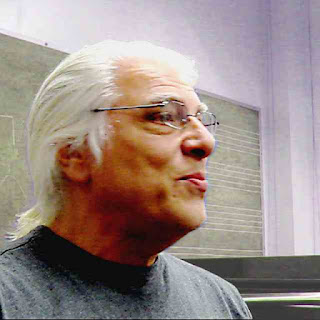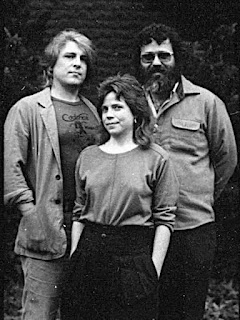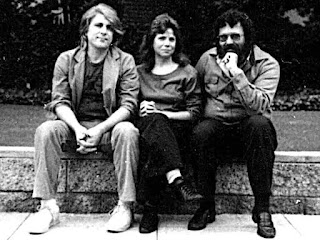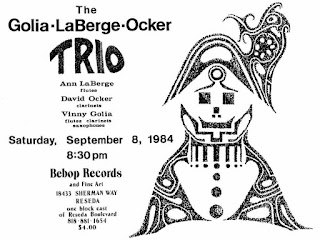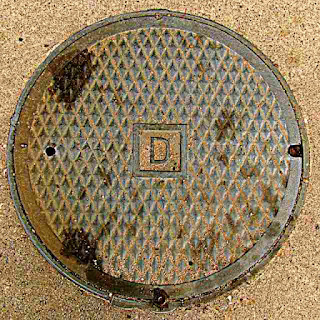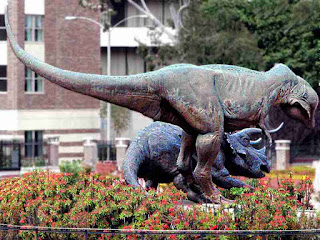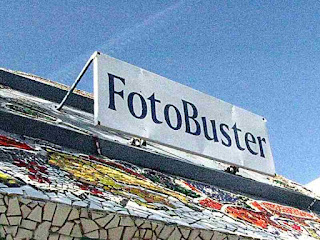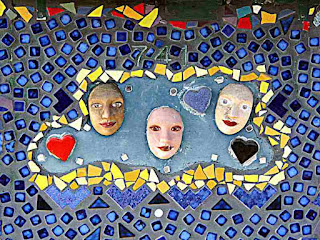There were four concerts total. Today, April 30, 2008 is the 30th anniversary of the second one. Here is the cover of the program book:
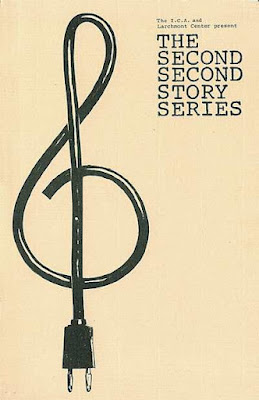
You can download the entire program book as a 17 meg. pdf file by clicking this sentence. The booklet is 28 pages. It includs all four programs with complete performer listings, program notes and biographies of each composer and many performers, plus other things common to all program books like advertisements and the full score to Terry Riley's In C on the back cover.
The Center for Yoga was (as I remember) an old lodge hall of some sort. Here are pictures showing the performing area. The first (scanned from a proof sheet) was taken from the balcony. This is a rehearsal of The Scream of a Night-Heron by Susan Palmer - with the violist missing.
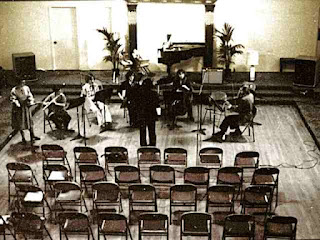
This picture shows the hall from the opposite direction. Composer Scott Fraser is well-posed while listening to playback of a magnetic tape piece. Above him you can see part of the balcony. Behind him are three large leather chairs.
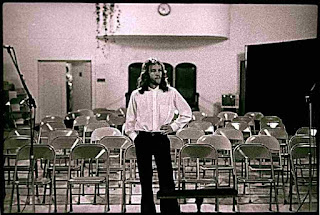
Here's a better view of those chairs - being used by Ganga White of the Center for Yoga and composers Richard Amromin and Scott Fraser again.

Here is a polaroid shot (taken by Rob Jacobs) of composers Pauline Oliveros and Anna Rubin. For information about Pauline Oliveros start here. Here's a link for Anna Rubin.

PROGRAM ONE - APRIL 16, 1978
MUSIC BY WOMEN COMPOSERS
MOBILE 4 JOHN CAGE for 5 radios (1978) -- Jan Greenwald
(world premiere)
SONG FOR THREE CLARINETS (1978) -- Lois Vierk
(world premiere)
CROTCHETS AND CONTRIVANCES for guitar and percussion (1977) -- Carey Lovelace
film by Roberta Friedman
INTERMISSION
SONGS TO DEATH for soprano, cello and piano (1976) -- Anna Rubin
poems by Sylvia Plath

for soprano, 4 clarinets, 4 percussion and glass players (1978) -- Pauline Oliveros
Rob Jacobs kept these pictures in this post safe since 1978. We do not remember the photographer of the black and white shots. More of Rob's own color Polaroid photos will be included in the remaining posts about this series. Rob's recent work as an artist can be found here and here.
Here are composers Susan Palmer and Rob Jacobs. Notice the person reading the program book in the upper right corner. (Click to enlarge any picture.)

PROGRAM TWO - APRIL 30, 1978
PHIELDS for magnetic tape (1977) -- Scott Fraser
THE SCREAM OF A NIGHT-HERON for soprano, fl, cl, bn, vln, vla, vcl (1978) -- Susan Palmer
(world premiere)
Lynn Griebling, soprano
CSUN Contemporary Ensemble, Daniel Kessner, conductor
THINGS IN THE NIGHT for magnetic tape (1978) -- Stephen Mitchell
(world premiere)
FOUR MINUTES A YEAR for clarinet/recorder and piano (1978) -- Robert Jacobs
(world premiere)
INTERMISSION
DURATION II for magnetic tape (1976) -- Jan Greenwald
CHAIN-REACTION I (pianos) (1973) -- Drew Lesso
(U.S. Premiere)
Three Time Zones & Resultants
Music Theatre
NONET for fl, cl, bn, hn, tp, tn, vln, vla, vcl (1975) -- Richard Amromin
the CSUN Contemporary Ensemble, Daniel Kessner, conductor
Here is composer Drew Lesso, on the left looking down at the 1978 video camera, with two other people, preparing for his piece Chain-Reaction I

Here is Chain-Reaction I in performance. For more pictures and information about Chain-Reaction I please click here.

Please tune in to Mixed Meters on May 7 and May 30 for the exciting continuation and conclusion of this series about the Independent Composers Association and The Second Second Story Series.
Second Story Tags: Independent Composers Association. . . ICA. . . concert series. . . composers association. . . new music. . . Center For Yoga. . . concert advertising. . . poster. . . second story

